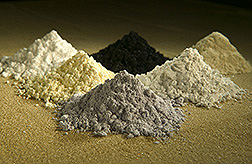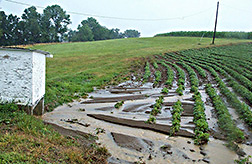A Rare-Earth Approach to Tracing Soil Erosion
Substances listed in their own niche of the Periodic Table of the Elements may represent the best way to track—and pinpoint sources of—soil erosion that causes billions of dollars in damage each year.
In rare-earth elements, ARS scientists John Zhang, a hydrologist, and Mark A. Nearing, an agricultural engineer, see a fast, accurate, and safe tool for documenting this erosion. It was Nearing who introduced the technology here, after preliminary studies in China.
Despite their name, rare-earth elements are actually abundant in Earth’s crust. They’re usually found in an oxidized form. Zhang and Nearing mix them with soil and distribute them with a device similar to a fertilizer spreader. Later, they collect samples of eroded soil, or sediment. In the lab, they can detect the rare-earth elements in the sediment samples either through instrumental neutron activation analysis or with a new technique they developed.
“All soil contains some rare-earth elements, so you have to be able to detect the tracer you are using,” says Zhang. “The trick is to ensure that there will be an adequate amount of tracer in the sediment—about three times the element’s concentration in the soil.”
There are 30 rare-earth elements. The scientists are working with seven lanthanide oxides: lanthanum, which is used in carbon lighting applications and optical glass manufacturing; cerium, used as a catalyst in self-cleaning ovens; praseodymium, commonly used in an alloy found in lighter flints and carbon electrodes for arc lighting; neodymium, used for coloring glass and ceramics and for filtering infrared radiation; samarium, used in magnets, in alloys with cobalt, and in nuclear reactors; and gadolinium, which is also used in magnets.
“Effective soil-erosion control requires a thorough understanding of how soil is detached, transported, and deposited along a hill slope or within a watershed,” says Zhang. “We examined how well these oxides reflect the actual movement of soil that they are placed on.”
The researchers say the fine-powder rare-earth elements are a more effective tool for tracking movement of eroding sediment than what’s currently the best tracer: minuscule amounts of the radioactive element cesium (137Cs) that originated from nuclear-bomb testing and spread across the landscape through the atmosphere. 137Cs, which has a half-life of 30 years, is traced with radiation-measuring equipment.
Soil erosion can also be tracked with naturally occurring radioactive nuclides, natural and fluorescent dye-coated particles, and small beads.
“Rare-earth elements have advantages over all these,” says Zhang. “They bind strongly to soil, are readily incorporated into soil aggregates, have high analytical sensitivity, are easy and inexpensive to measure, don’t interfere with sediment transport, and have low plant uptake.”
“And the main advantage,” says Nearing, “is that rare-earth elements provide multiple tracers. With cesium, pinpointing the erosion’s source is difficult because there’s no differentiation among sites of origin. With rare-earth elements, we can use five or six tracers on the same field and tell precisely where certain soil eroded from.”
Nearing emphasizes that none of the tracers currently used presents any risk to the environment or to the user.
|
|
A New Extraction Method, Too
Zhang and Nearing have developed and tested a quick, acid-leaching method for extracting for analysis these oxides from soil and sediment samples.
The technique employs inductively coupled plasma-mass spectrometry, a widely used technique for routine determination of trace elements in liquids. “It may help scientists better understand soil transport, and it could aid conservationists as they develop and evaluate new erosion-control measures,” says Nearing.
The researchers started working with rare-earth elements when they were with ARS’s National Soil Erosion Research Laboratory in West Lafayette, Indiana. Zhang now works with ARS’s Grazinglands Research Laboratory in El Reno, Oklahoma, and Nearing is now with ARS’s Southwest Watershed Research Center in Tucson, Arizona.
Zhang first explored rare-earth elements’ effectiveness with small-scale plot studies. Nearing conducted large-scale studies with the elements on ARS’s North Appalachian Experimental Watershed in Coshocton, Ohio.
“These tracers were first used in China,” says Zhang. “But those studies were limited. We’ve confirmed their ability to bind to soil—the most important aspect of this technology.” Zhang found that the most severe soil erosion occurred in the upper-middle part of a slope. “The rare-earth elements traced sediment movement and redistribution with fairly good accuracy,” he says.
Nearing—with help from Zhang and Akitsu Kimoto, who is doing postdoctoral work funded by Japan—is studying the oxides’ performance in watersheds in the semiarid American Southwest’s alluvial soil near Tombstone, Arizona.
Overcoming Preferential Binding
Nearing says the powdered tracers bind well to the gravelly, sandy-loam soils typical of the Southwest’s rugged rangelands. And although this work revealed that the tracers have a quirky trait, the researchers have found two effective ways to deal with it.
“We noticed that rare-earth elements bind better to fine-sized particles than to sand-sized ones,” he says. “This preferential binding would skew your results if you simply measured detectable tracers in an intact sample.”
The team found that this can be avoided by either premixing the tracers with separate size classes of soil particles, then allowing them to bind before spreading them on the ground, or—later on, when field samples are collected—separating the samples by particle size before measuring the tracers.
“When we applied tracers to soil samples, poured water over them, and then separated the samples into four different particle-size classes, we found that we could detect the tracers to within 4-percent accuracy, which is very acceptable,” Nearing says.
Nearing wants to use tracer data to increase the accuracy of math-based models that predict erosion from rugged rangelands. “That could aid managers of flood-control structures who need to anticipate how much sediment can move downstream after rainstorms,” he says. “And it might help cattle ranchers fine-tune grazing plans and thus safeguard sensitive parts of the landscape.”—By Luis Pons andMarcia Wood, Agricultural Research Service Information Staff.
This research is part of Water Quality and Management, an ARS National Program (#201) described on the World Wide Web at www.nps.ars.usda.gov.
John X. Zhang is at the USDA-ARS Grazinglands Research Laboratory, 7207 W. Cheyenne St., El Reno, OK 73036; phone (405) 262-5291, fax (405) 262-0133.
Mark A. Nearing is at the USDA-ARS Southwest Watershed Research Center, 2000 E. Allen Rd., Tucson, AZ 85719; phone (520) 670-6481, ext. 152, fax (520) 670-5550.
"A Rare-Earth Approach to Tracing Soil Erosion" was published in the June 2005 issue of Agricultural Research magazine.









